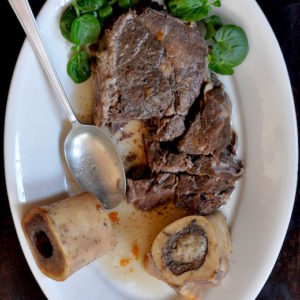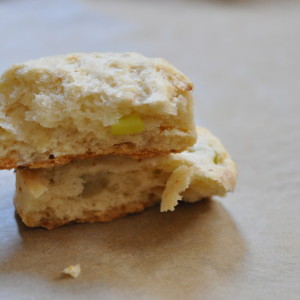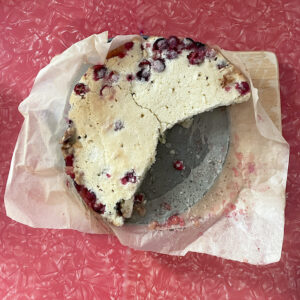Laurie Colwin’s Boiled Beef
Last week, between bouts of doomscrolling, I remembered Laurie Colwin’s essay about boiled beef.
The best boiled beef I ever ate was at the Ukrainian Restaurant at the Ukrainian National Home on the Lower East Side of Manhattan. I would gladly go out in a violent storm and walk over broken glass to have some. It was rich and savory and tasted like essence of prime rib–how they did it I cannot imagine.
Laurie Colwin, More Home Cooking

Colwin’s recipe is utter simplicity. No presalting the beef, no browning, no insulating the pot with salt pork. Just meat, a few vegetables, and water (or broth, if you’re cheating).
Boiled beef may be cooked atop the stove or in the oven. However you cook it, be prepared: low and slow is the name of the game.

Unrelated. Obviously.
Colwin gave her beef a brief blanching in cold water before cooking it. There is much to be said for this step, but I live in a place where rain is rare and a pot of water is dearer than a tank of gasoline.

A word on the vegetables: if you are bothered by mushy vegetables, you can start a batch when you begin cooking the beef, and then add a fresh batch of veg halfway through cooking. This does mean, however, that you must tear yourself away from doomscrolling long enough to stop the cooking and strain out the first batch of veg. Instead, I added half the vegetables at the beginning of cooking, tossing the remainder into the pot at half-time. I left the first batch in. Some people sieve their mushy vegetables. These people often have dishwashers. This leaves them time to wash dirty sieves. Also patience. I have neither.

This leads us to serving the boiled beef. In her essay, Colwin describes her fondness for covering the multicultural waterfront with her boiled beef, serving a variety of condiments including Indian Lime Pickle, cornichons, salsa verde, and horseradish. As I am feeding two people with tiny appetites, I limit myself to mustard (him) and horseradish (me). I should have served cornichons, as we both love them, but I forgot.

Leftovers may be treated numerous ways. A surfeit of broth naturally leans soupward. You can also boil the broth down into jus. Either of these may be frozen or pressure canned (not water bath canned–water bath canners cannot achieve sufficient pressure to give a safe product). You can toss some pasta into your leftovers, or add poached eggs. Throw them into a frying pan and allow them to brown, and you have a bastardized but delicious version of English bubble and squeak.

Before closing it must be said there are fancier recipes out there for boiled beef; I have prepared them. And delicious they are. But at times like these, when the news makes getting up a major effort, simple is just fine. We must hold out hope–and I know that can be a tall order–that things will get better.

Until they do, our hearts and minds are with the Ukranian people.

Boiled Beef
Adapted from Laurie Colwin’s More Home Cooking
Please see notes, below, before cooking.
Prep time: about 10 minutes. 3-5 hours cooking
Yield: 3-4 servings. Easily scaled upward.
1.5 pounds/about half kilo bone-in short ribs, trimmed to fit your pot, beef chuck, or shin
2-3 carrots, scrubbed if organic, peeled if not, sliced
1-2 parsnips, peeled and sliced
1-2 white or yellow onions, peeled and sliced
2-5 potatoes, any kind, peeled or not (scrub if unpeeled) and chunked
Additional vegetables are suggested in notes, below
2-6 cloves garlic, peeled and smashed
1 teaspoon sweet paprika
bay leaf
salt and pepper
a few dried cepes, optional
water or unsalted chicken broth
You will need a large lidded braising pot to make boiled beef. I used a Staub 5 quart/liter braiser.
Preheat the oven to 325F/160C
Put the beef, vegetables, and garlic in the pot. Add the dried mushrooms, if using. Season with one teaspoon paprika, two teaspoons salt, and a generous grind of black pepper, or a generous teaspoon.
Add the water or broth, filling the pot about 3/4 full; don’t submerge the meat.
Place in oven, uncovered, or atop stove, and cook, 3-5 hours. Add lid only if food is browning rapidly or liquid is evaporating. This is unlikely.
While the beef cooks, immerse yourself in the suggested reading, below.
Serve boiled beef with bread, green salad, horseradish and strong mustard.
Leftovers will keep, refrigerated, up to five days. The beef and broth may be frozen up to three months. Remove the vegetables, as they will turn to mush in the freezer.
Notes:
A variety of beef cuts work in this dish. The unifying element is they’re all tough and require long cooking to become edible. I used short ribs, but rump, chuck, or shin, even stewing beef would work.
You can use a few vegetables or a lot. This is a dish that does well with root veg like turnips, rutabagas, and potatoes. Radishes, which are just coming into season, are delicious roasted. Try them.
Don’t use brassicas, as long cooking turns them sulfurous and unpleasant.
I cooked my beef in chicken broth, and you can, too, provided your broth isn’t too salty. Beef broth would also work. But good old water is just fine.

In my last post, I promised to post a list of places to help Ukraine. Since then, multiple outlets have done so, rendering my well-intentioned offer redundant. John and I donated to World Central Kitchen.
Readers wishing to follow current events and/or learn more about Ukrainian food and culture should look at the following accounts/books:
@oliahercules, a Ukranian chef and writer now living in England, and @alissatimoshkina, a Russian author, cook, and close friend of Olia’s, also living in England. They are working together nonstop to provide information and assistance to Ukrainians and Russians in need.
Other useful links/books/people:
@darra.goldstein, an expert on Russian food and culture. Darra lives in Massachusetts. Her most recent book is Beyond The North Wind: Russia in Recipes and Lore.
@vonbremzen: Anya von Bremzen is a Muscovite living in New York City. The excellent Please To The Table covers the foods of the then-USSR and surrounding countries.
—
Finally, English food writer Lesley Mackley died unexpectly last weekend. The author of ten cookbooks, Lesley was highly regarded by her peers and deeply respected by her audience. We knew each other online but never got to meet in person. She deserved to be better known in the United States, and her death leaves a gap.





